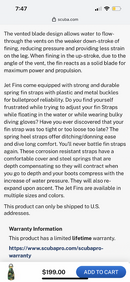Eric Sedletzky
Contributor
What exactly are the vents supposed to do on Scubapro Jet fins?
I was looking at them and wonder if they are actually counter productive?
It looks to me like on the downward stroke of a standard from the hip flutter kick that water will gush through those vents but what would be the benefit?
It seems like that’s wasted thrust.
I know those Scubapro version fins are from a 1965 design but what sort of science were those fins based on? Or was there any?
Was it a marketing gimmick?
People use them now doing all sorts of frog kicks, helicopter turns, backing up, etc. and love them, but back then nobody was doing that stuff (that I’ve heard about anyway), it was all standard flutter kicking.
I can confirm that they do suck for regular flutter fin kicking, but they do work well for everything else.
I was looking at them and wonder if they are actually counter productive?
It looks to me like on the downward stroke of a standard from the hip flutter kick that water will gush through those vents but what would be the benefit?
It seems like that’s wasted thrust.
I know those Scubapro version fins are from a 1965 design but what sort of science were those fins based on? Or was there any?
Was it a marketing gimmick?
People use them now doing all sorts of frog kicks, helicopter turns, backing up, etc. and love them, but back then nobody was doing that stuff (that I’ve heard about anyway), it was all standard flutter kicking.
I can confirm that they do suck for regular flutter fin kicking, but they do work well for everything else.




